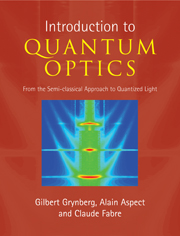Book contents
- Frontmatter
- Contents
- Foreword
- Preface
- Acknowledgements
- Part I Semi-classical description of matterlight interaction
- 1 The evolution of interacting quantum systems
- Complement 1A: A continuum of variable width
- Complement 1B: Transition induced by a random broadband perturbation
- 2 The semi-classical approach: atoms interacting with a classical electromagnetic field
- Complement 2A: Classical model of the atom-field interaction: the Lorentz model
- Complement 2B: Selection rules for electric dipole transitions. Applications to resonance fluorescence and optical pumping
- Complement 2C: The density matrix and the optical Bloch equations
- Complement 2D: Manipulation of atomic coherences
- Complement 2E: The photoelectric effect
- 3 Principles of lasers
- Complement 3A: The resonant Fabry–Perot cavity
- Complement 3B: The transverse modes of a laser: Gaussian beams
- Complement 3C: Laser light and incoherent light: energy density and number of photons per mode
- Complement 3D: The spectral width of a laser: the Schawlow–Townes limit
- Complement 3E: The laser as energy source
- Complement 3F: The laser as source of coherent light
- Complement 3G: Nonlinear spectroscopy
- Part II Quantum description of light and its interaction with matter
- Part III Applying both approaches
- Index
Complement 1B: Transition induced by a random broadband perturbation
Published online by Cambridge University Press: 05 August 2012
- Frontmatter
- Contents
- Foreword
- Preface
- Acknowledgements
- Part I Semi-classical description of matterlight interaction
- 1 The evolution of interacting quantum systems
- Complement 1A: A continuum of variable width
- Complement 1B: Transition induced by a random broadband perturbation
- 2 The semi-classical approach: atoms interacting with a classical electromagnetic field
- Complement 2A: Classical model of the atom-field interaction: the Lorentz model
- Complement 2B: Selection rules for electric dipole transitions. Applications to resonance fluorescence and optical pumping
- Complement 2C: The density matrix and the optical Bloch equations
- Complement 2D: Manipulation of atomic coherences
- Complement 2E: The photoelectric effect
- 3 Principles of lasers
- Complement 3A: The resonant Fabry–Perot cavity
- Complement 3B: The transverse modes of a laser: Gaussian beams
- Complement 3C: Laser light and incoherent light: energy density and number of photons per mode
- Complement 3D: The spectral width of a laser: the Schawlow–Townes limit
- Complement 3E: The laser as energy source
- Complement 3F: The laser as source of coherent light
- Complement 3G: Nonlinear spectroscopy
- Part II Quantum description of light and its interaction with matter
- Part III Applying both approaches
- Index
Summary
We have seen in Section 1.2 that a transition between two discrete levels |i〉 and |k〉 is possible when the system is submitted to a perturbation which has a non-zero Fourier component close to the Bohr frequency ω0 = (Ek − Ei)/ħ of the transition. This is the case when the perturbation Ĥ1(t) is sinusoidal, of the form Ĥ1(t) = Ŵ cos(ωt + φ), and oscillates at a frequency ω close to ω0. But in many real physical situations, the perturbation is not perfectly mastered: it is a pure sine function only for times shorter than a limit, called the coherence time. At longer times, the oscillating perturbation has a phase and an amplitude that vary randomly. This is, for example, the case when the perturbation is due to an incident electromagnetic wave produced by a thermal lamp, in which the thermal fluctuations induce random variations of the amplitude and phase of the wave. As the perturbation is no longer a pure sinusoidal wave, its Fourier spectrum is no longer a Dirac delta function. It has some finite width around a mean frequency. For this reason a random perturbation is also called a ‘broadband’ perturbation.
We shall determine in this complement the temporal evolution of the quantum system submitted to such a random perturbation. We shall see that the transition probability between two discrete levels is proportional to T for small interaction time T, and has an exponential behaviour at long times, a result which is very similar to that obtained for a transition between a discrete level and a continuum.
- Type
- Chapter
- Information
- Introduction to Quantum OpticsFrom the Semi-classical Approach to Quantized Light, pp. 38 - 44Publisher: Cambridge University PressPrint publication year: 2010

